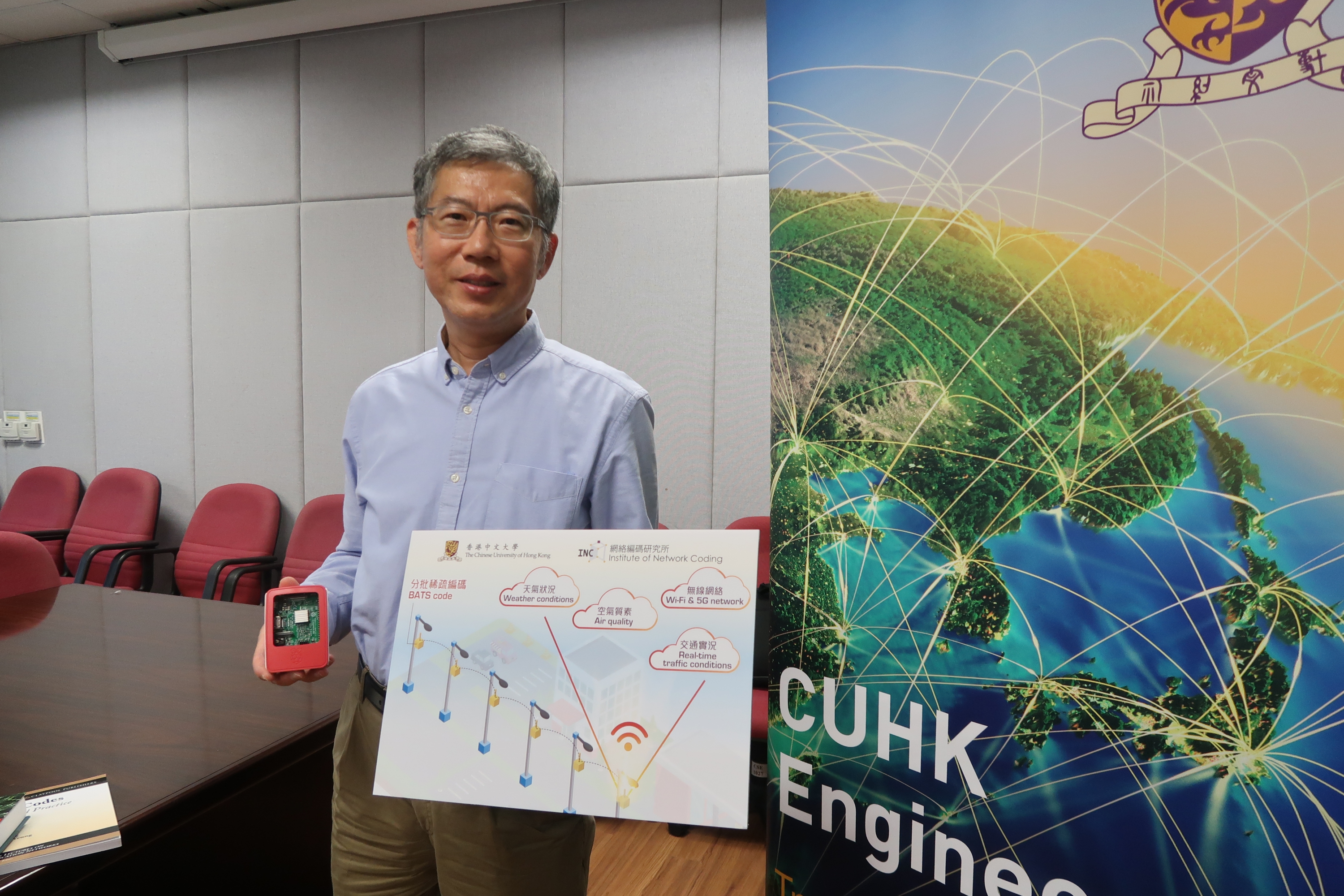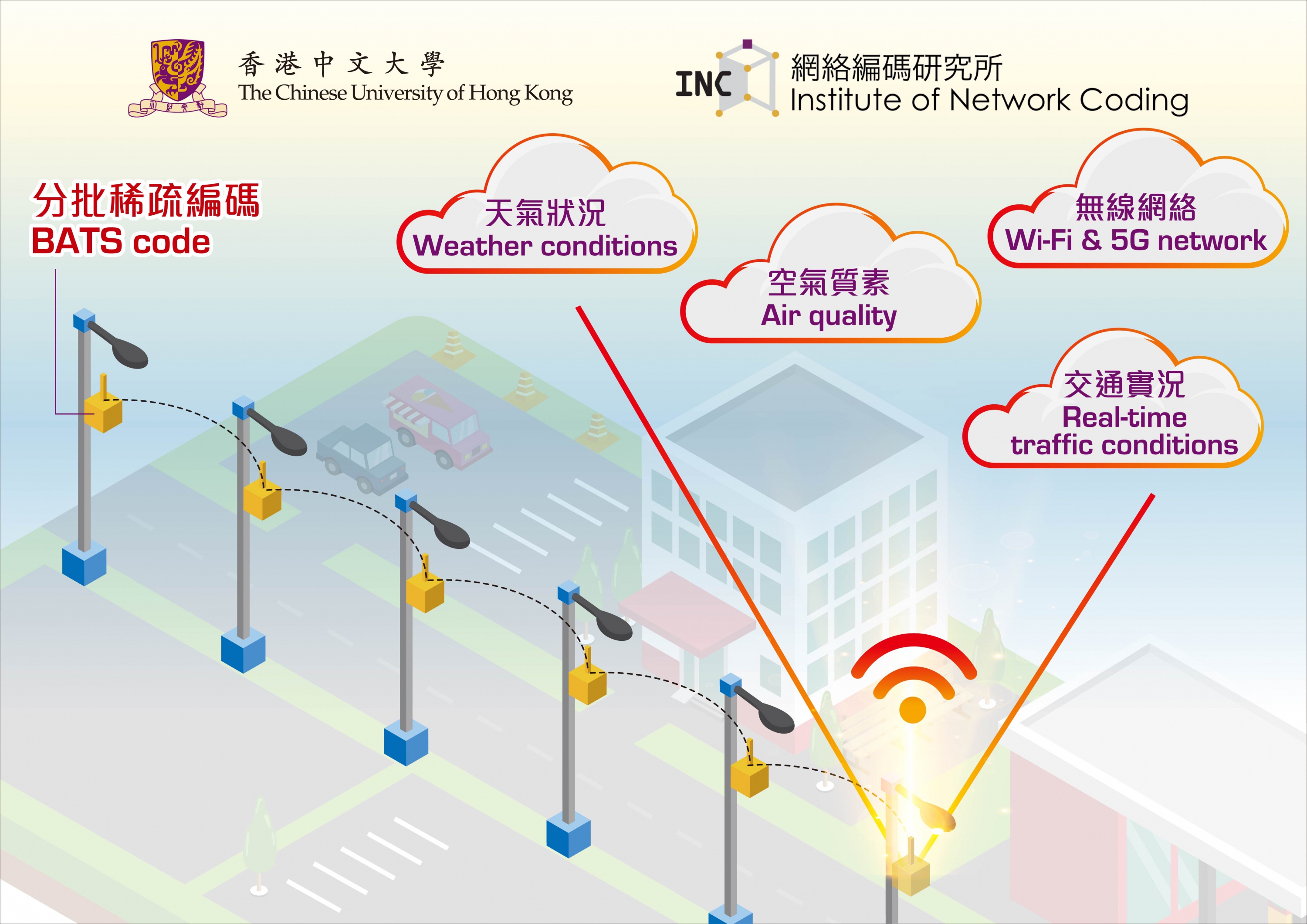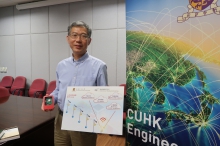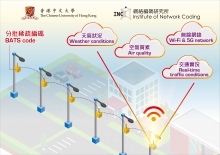CUHK
News Centre
Smart Hong Kong City Development SeriesCUHK Faculty of Engineering Develops BATS Code for Efficient Network Transmission Enabling Multi-functional Lampposts to Provide Smart Services
The Smart City Blueprint for Hong Kong, recently released by the Hong Kong government in the latest policy address, unveils the launching of a multi-functional smart lampposts pilot scheme at urban locations to provide convenient data services and collect real time city management data like transportation, weather and environment. Equipped with sensors, data networks and related facilities, the smart lampposts can help transform Hong Kong into a smart city through the provision of information and digital services such as Wi-Fi and future 5G networks and base stations. The transmission rate and installation cost of communication networks are a significant factor to consider so this innovation is set to receive invaluable support from an invention coming from The Chinese University of Hong Kong (CUHK).
A research team led by Prof. Raymond W. Yeung, Choh-Ming Li Professor of Information Engineering and Co-Director of the Institute of Network Coding (INC) at CUHK, has invented BATched Sparse code (BATS code) to improve the network transmission rate of networks with packet loss. It is one of the world’s most mature networking techniques in which transmitted data is encoded and decoded to increase network throughput, reduce delays and make the network more robust. The potential application of BATS code includes a wide spectrum of areas such as Internet of Things (IoT), fog computing, underwater and satellite communication systems and disaster communications, breaking geographical boundaries with technologies. The team is now in the process of applying to Institute of Electrical and Electronics Engineers (IEEE) to make BATS code one of the international wireless communication standards.
Pioneering Network Coding Technologies
As an efficient linear network coding solution, BATS code replaces routers with coders that transmit ‘evidence’ of a message instead of sending the message itself, and overcomes the problem of data loss during wireless transmission, and offers higher speed, reliability and stability. Compared with conventional random linear network coding, BATS code offers a lower encoding and decoding complexity, and requires a much smaller buffer size at the intermediate nodes. For example, for a multihop network, BATS code can increase the transmission rate by 56% and reduce the loss rate by 29%. With 7 years of Prof. Yeung’s team effort, the performance of BATS code has proven remarkable in making network communications more efficient, reliable, stable and secure.
BATS code not only helps to compensate for the network loss, it improves the throughput for multicast with just minimal storage capacities and hardware requirements. In principle, a basic low-power communication hardware will suffice to consistently achieve a high transmission rate for multi-hop wireless networks with hundreds to a thousand nodes (the number of intermediate nodes or liner networks). In other words, this makes BATS code ideal for implementation on multi-functional smart lampposts especially when extra large-scale infrastructure and fiber network upgrade are not needed for transferring data to the server. More importantly, the advantages of BATS code, which include high throughput, low latency and low storage requirement, strongly favour transforming Hong Kong into a smart city.
Cross-disciplinary Research Collaborations
BATS has already obtained a number of patents in Europe and the US. Thus far, the team has been actively in touch with the Hong Kong Applied Science and Technology Research Institute to explore the opportunities for collaboration on their smart city’s lampposts scheme, with Beijing’s aviation technology units for its application in satellite communication, and with the University in Nova Scotia, Canada for testing of acoustic signals in underground communication. BATS code can particularly tackle the problem of data loss in the ocean, and, in turn, facilitate the civil monitoring process on underwater builds. Looking ahead, Prof. Yeung hopes that by introducing BATS code into hot air balloons or aerial photography, setting up wireless networks and emergency rescue and communication works will become less difficult in remote and hilly districts, and that BATS code will have great potential for benefiting mankind.
Meanwhile, the team has been invited to work in different fields on promoting fog computing, a conceptual extension of cloud computing. The objective is to reduce the network congestion and streamline the algorithms and layering. CUHK and INC are the only two institutional members of OpenFog Consortium in Hong Kong. Prof. Yeung remarked, “There is a strong correlation between fog computing and Internet of Things (IoT); for example, the industrial and medical application of smart robots and Internet of Vehicles (IoV), which came under the umbrella of IoT. BATS code is one of the keys to making IoT possible”.
The network coding theory which originated at CUHK is a major breakthrough in information sciences. Its fundamental concept was introduced in the late 1990s, largely due to the work of Prof. Raymond Yeung, and has become an innovative network coding technique to revolutionise the world of wireless communications. Prof. Yeung hopes that with this breakthrough technology from CUHK, BATS code will be shared to realise Hong Kong’s smart city vision and its infrastructure-based development, and to make Hong Kong a world-class smart city.
A Top Hong Kong Research Leader in Wireless Communications
Prof. Raymond Yeung is an internationally acclaimed expert in the area of communication and information theory, currently serving as Choh-Ming Li Professor of Information Engineering, and Co-Director of INC. Recently, his paper titled “Network Information Flow” was among those selected for the 2018 ACM SIGMOBILE Test-of-Time Paper Award, a first for Hong Kong researchers. It has given profound indication and acknowledgment of the impact of Prof. Yeung’s work.
In recognition of his achievements, he was also honoured with numerous awards in his early years, including the Friedrich Wilhelm Bessel Research Award from the Humboldt Foundation in Germany, a Croucher Senior Research Fellowship, and the IEEE Fellowship. In 2016, Prof. Yeung and his collaborators were granted the prestigious IEEE Eric E. Sumner Award for their pioneering contributions to the field of network coding. As of now, they were the only research team in Asia Pacific to receive this honour. His textbooks on Information Theory and Network Coding have been widely adopted by over 100 universities and research institutes around the world.
About INC
INC was established in 2010 with funding support from the Areas of Excellence Scheme under the Research Grants Council (RGC) of the HKSAR Government and a matching grant from CUHK. It is the world’s first institute which conducts cutting-edge research on the theory of network coding and its various applications in internet communications, wireless communications, information security, and cloud data storage. It aims to strengthen Hong Kong’s leading position in network coding by publishing original research findings and transferring advanced technologies based on such findings.
CUHK Engineering Series: Smart Hong Kong City Development
CUHK is one of the pioneers in the research on artificial intelligence (AI) and deep learning. It has already received top awards in international challenges for face recognition and visual recognition. The CUHK Multimedia Laboratory was named as one of the pioneers in AI research, the only institution in Asia to receive this recognition, alongside the University of California, Berkeley, the Massachusetts Institute of Technology, Stanford University and the University of Oxford. Different research teams in the Departments of Information Engineering, Electronic Engineering, Systems Engineering and Engineering Management, and Computer Science and Engineering at the Faculty of Engineering are also dedicated to the application of AI and deep learning in various areas, such as smart living, smart mobility and smart environment, in order to build Hong Kong into a world class smart city. In the future, the Faculty will launch more innovative projects that make use of AI to improve the quality of human life and will share these with the public through the ‘Smart Hong Kong City Development’ Series.
Demonstration of a video streaming comparison of BATS and fountain codes in a two-hop network can be viewed at http://iest2.ie.cuhk.edu.hk/~whyeung/BATS.mp4
Prof. Raymond W. Yeung, Choh-Ming Li Professor of Information Engineering and Co-Director of the Institute of Network Coding is now applying to make BATS code one of the international wireless communication standards. Prof. Yeung’s team has also been actively in touch with various electronic infrastructure supplier to explore its application in smart lampposts, communication and Internet of Things.







